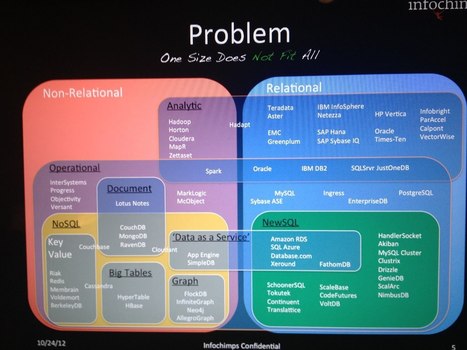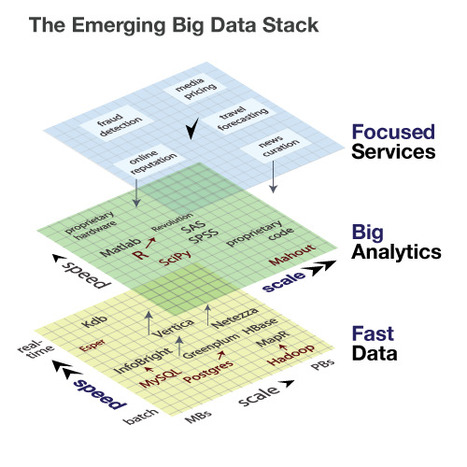 Your new post is loading...
 Your new post is loading...
Here’s the NoSQL landscape in 3 slides.
The innodb_memcache daemon plugin is a plugin for the MySQL Server end contains an embedded memcached. This embedded memcached is configured to use MySQL's InnoDB engine as storage backend. By using this data stored inside an InnoDB table can be accessed using memcache's key-value protocol. Back in the times of the previous blog post this was limited to data from a single table, which maps easily to the key-value nature of memcache but is a clear limitation.
Spanner is Google's scalable, multi-version, globally-distributed, and synchronously-replicated database. It is the first system to distribute data at global scale and support externally-consistent distributed transactions. This paper describes how Spanner is structured, its feature set, the rationale underlying various design decisions, and a novel time API that exposes clock uncertainty. This API and its implementation are critical to supporting external consistency and a variety of powerful features: non-blocking reads in the past, lock-free read-only transactions, and atomic schema changes, across all of Spanner.
For the past few days I've been working on a proof of concept PhoneGap application that demonstrates an example of database synchronization. This is a fairly complex topic and I'm only going to demonstrate one version of this, but I hope the concepts, code, and example application are useful to people hoping to tackle the same problem. Before we start digging into code, let me explain what the application will demonstrate and the type of synchronization it will use. Our sample application is going to use a built-in database for documentation. Most mobile applications don't really have a lot of documentation. Anything that complex may not make sense on mobile anyway. But for whatever reason you want to use, the application has a large set of documents stored in the database. This documentation may or may not ship with the application, but we want the application to sync with a remote server in order to get the latest and greatest documentation. Our synchronization "rules" will be simple: - If the remote server adds new docs, the app needs to get it. - If the remote server updates existing docs, the app needs to update its copy. - If the remote server deletes a doc, the app needs to delete its local copy. In this scenario, we don't have to worry about user generated content and handling updates bidirectionally. That allows us to simplify things quite a bit.
Jeremy Cole, a DBA Team Lead/Database Architect at Twitter, gave a really good talk at the O'Reilly MySQL conference: Big and Small Data at @Twitter, where the topic was thinking of Twitter from the data perspective.
One of the interesting stories he told was of the transition from Twitter's old way of storing tweets using temporal sharding, to a more distributed approach using a new tweet store called T-bird, which is built on top of Gizzard, which is built using MySQL.
This article explains how MongoDB schema differs from an equivalent RDBMS schema, and how common relationships between entities are replicated in MongoDB.
Couchbase Mobile for iOS brings the power of Apache CouchDB to native iOS application developers. A powerful local database, it can also automatically synchronize with a Couchbase cluster “in the cloud” any time network connectivity is available.
While SQL databases are insanely useful tools, their monopoly of ~15 years is coming to an end. And it was just time: I can't even count the things that were forced into relational databases, but never really fitted them. But the differences between "NoSQL" databases are much bigger than it ever was between one SQL database and another. This means that it is a bigger responsibility on software architects to choose the appropriate one for a project right at the beginning. In this light, here is a comparison of Cassandra, Mongodb, CouchDB, Redis, Riak, Membase, Neo4j and HBase:
According to Ohloh, MySQL and MongoDB have little in common. One’s seen commits from over a thousand people, the other shy of sixty. One’s 1.1M+ lines of code, the other not even two hundred thousand. And architecturally, the projects are quite distinct.
But in many respects, MongoDB is the new MySQL.
Not because MongoDB is a replacement, as Joseph Ritchey argues in his piece “MongoDB is the New MySQL.”
It is certainly true that there are instances of MongoDB replacing MySQL. It is equally true that there are instances of MongoDB being replaced. In at least one instance, by MySQL. What MongoDB is doing, however, and doing well, is playing a role similar to the one MySQL began playing a decade ago.
Learn how to migrate from MySQL to CouchDB: Read Signal's story.
CouchDB is document oriented, schema-free database similar to Amazon’s SimpleDB and Google’s BigTable. It stores data as JSON documents and provides a powerful view engine that lets you write Javascript code to select documents from the database, and perform calculations. A RESTful HTTP/JSON API is used to access the database. The database boasts other features as well, such as robust replication, and bi-directional conflict detection and resolution.
As NodeJS grows supporting libraries continue to be developed and evolve. Chad Lung explains how to use one of the many MySQL libraries available for NodeJS: node-mysql.
InnoDB is very different from MyISAM in how it stores data and how the indexes works. InnoDB uses an index-organized data storage technique, wherein the primary key acts as the clustered index and this clustered index holds the data. There is no separate storage of data, its stored within the clustered index in the leaf nodes.
Its for this reason that understanding the basics of InnoDB primary key is very important, and hence the need for these notes. The purpose of these notes is to help you with selecting the correct primary keys.
In a blog post following a recent report by the 451 Group, Matthew Aslett, a senior analyst for the research firm, defines a new breed of SQL database-related products he labels as “NewSQL”.
According to the 451 Group, NewSQL refers to “various new scalable/high performance relational database products and services which are designed to bring the benefits of the relational model to distributed architectures or to improve the performance of relational databases…”
|
If you still haven’t found the time to learn how to install, configure, and maintain a database, you might be interested in a cloud solution that promises “zero management.” Xeround sells itself as the “zero-management database.” Managing databases consumes thousands of hours every year, becoming yet another time sink to sys admins and developers alike. Management includes everything from installation through upgrades, checking on server health and disk space, and scaling and managing these things at scale – something that every one of us could learn, given a few books and the time if we could find it. Fully managed databases (DBs) aren’t new, and Xeround isn’t the first, but it has focused on the things that cause plenty of pain. Keeping a DB running and scaling it. After housing, powering, and securing the physical machines, configuring them is the next task that can distract from actually building an app. Although you might have edge case requirements that need specially honed and tweaked database servers, chances are … you don’t really. In most cases, you can do a lot with a good standard config file and focus your efforts on the architecture of the app using these standard configs. Once you’ve given up your grip on the config files and the SSH into the box, you can focus on the app again. It’s okay to make apps and not be a slave to sys admin duties all the time.
Scalability is one of the main drivers of the NoSQL movement. As such, it encompasses distributed system coordination, failover, resource management and many other capabilities. It sounds like a big umbrella, and it is. Although it can hardly be said that NoSQL movement brought fundamentally new techniques into distributed data processing, it triggered an avalanche of practical studies and real-life trials of different combinations of protocols and algorithms. These developments gradually highlight a system of relevant database building blocks with proven practical efficiency. In this article I’m trying to provide more or less systematic description of techniques related to distributed operations in NoSQL databases.
In the rest of this article we study a number of distributed activities like replication of failure detection that could happen in a database. These activities, highlighted in bold below, are grouped into three major sections:
- Data Consistency - Data Placement - System Coordination
As its name implies, MemSQL achieves its fast performance in part by keeping data in memory, but it doesn’t use memcached like Facebook does to keep its massive MySQL deployment up to speed. Rather, MemSQL takes a lesson learned from HipHop — Facebook’s tool for converting PHP code into faster C++ — and converts SQL to C++. “This is like HipHop for SQL, essentially,” Frenkiel told me during a recent call. All told, he claims MemSQL performs up to 30 times faster than disk-based databases. “If you make money off your data and you actually measure time in microsecond or milliseconds,” he said, “then using a lightning fast DB like ours makes a lot of sense.”
MySQL Cluster 7.2 offers a range of new capabilities designed to enable the delivery of next generation web services, enhance cross data center scalability and improve ease-of-use, whether deployed on-premise or in the cloud: - New NoSQL Interface and Schema-less Storage with the native Memcached API - New multi-site clustering with auto-sharding and synchronous replication between datacenters - 70x Higher JOIN Performance with Adaptive Query Localization
Wouldn’t it be nice to have an elastically scalable database? NuoDB is a re-think of relational database technology, targeted at an elastic cloud of computers rather than a single computer system. What sets NuoDB apart from other NewSQL and NoSQL solutions is the many distinctive features that underpin its unique architecture. Chief among them is the manner by which multiple nodes cooperate to manage the state of the database.
Unlike traditional database architectures that are centralized with centralized transaction log files and query-processing, NuoDB manages transactions and queries in a de-centralized way, much in the way that peer-to-peer systems such as BitTorrent operate.
Live overview : https://www3.gotomeeting.com/register/686857446
MySQL is one of the most popular free and open source programs in history. It's the database backbone for thousands of websites and could arguably be given credit (along with Linux®) for the explosive growth of the Internet over the past 10 years. So, if MySQL is so important, why is increasing amount of high profile off-shoots of the core MySQL product? Because MySQL is free and open source, developers have always been able to take the code, modify it as they see fit, and distribute it on their own. For a long time, there weren't any branches of MySQL that a developer would trust in their own production environment. However, that's changing rapidly. Several branches are getting a lot of attention. This article will discuss three popular branches of MySQL that are gaining attention: Drizzle, MariaDB, and Percona Server, including the XtraDB engine. This article will talk briefly about the reasons for each branch and their goals, and whether to use them in your own production environment. By the time you finish this article, you should be able to answer the question "Are these MySQL branch products a good solution for my environment?"
The mysqlnd replication and load balancing plugin for mysqlnd makes using MySQL Replication from PHP much easier. Details here : http://blog.ulf-wendel.de/?p=316
A new breed of startup is emerging, built to take advantage of the rising tides of data across a variety of verticals and the maturing ecosystem of tools for its large-scale analysis. These are data startups, and they are the sumo wrestlers on the startup stage. The weight of data is a source of their competitive advantage. But like their sumo mentors, size alone is not enough. The most successful of data startups must be fast (with data), big (with analytics), and focused (with services).
Relational databases define a strict structure and provide a rigid way to maintain data for a software application. Apache's open source CouchDB offers a new method of storing data, in what is referred to as a schema-free document-oriented database model. Instead of the highly structured data storage of a relational model, CouchDB stores data in a semi-structured fashion, using a JavaScript-based view model for generating structured aggregation and report results from these semi-structured documents. CouchDB has been developed from the ground up with Web applications as the primary focus and has its sights on becoming the de-facto database for Web application development.
Overview of exciting features in CouchDB. This article is a high-level overview of CouchDB features, not a tutorial.
JavaScript can access the database directly
Replication
JSONP for Free
Changes API
Authentication and Session Support
...
Oracle released a technology preview this week a new version of MySQL that adds support for a Memcached plugin daemon for accessing InnoDB, MySQL's default storage engine.
It's available from MySQL Labs. The plugin daemon is only available for Linux at this time.
OWASP LA 2011 slides of Bryan Sullivan, Senior Security Researcher, Adobe Secure Software Engineering Team. More info on the blog : http://blogs.adobe.com/asset/
|
 Your new post is loading...
Your new post is loading...
 Your new post is loading...
Your new post is loading...



























